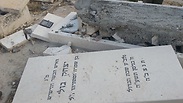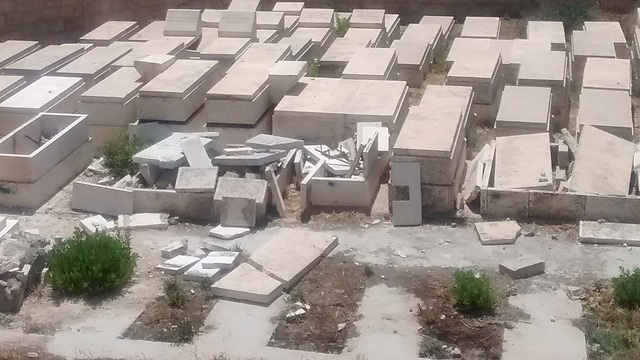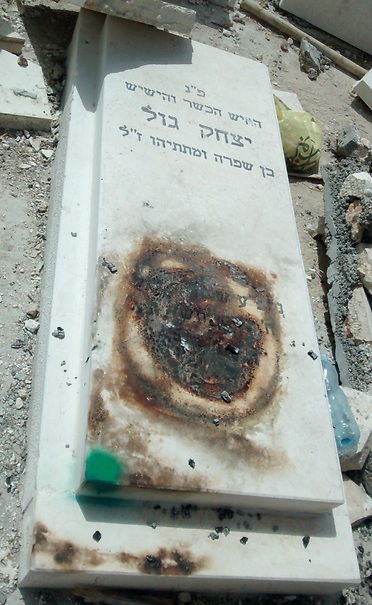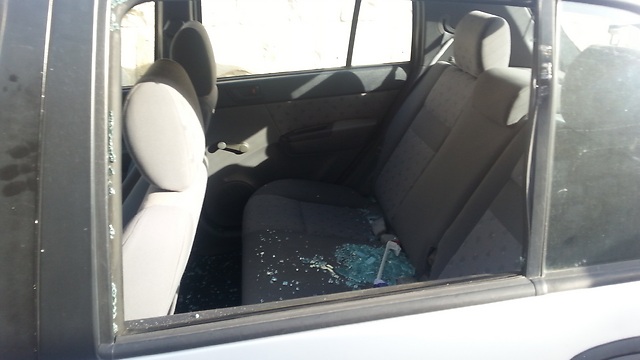
Dismay at continued vandalism at Mount of Olives cemetery
Former Italian model Mirella Petteni Haggiag can be seen walking around the 3,000-years-old cemetery with a garbage bag, cleaning up the trash and dirty diapers left by Palestinian vandals, who also smash and burn tombstones.
Yochanan Gol looks at his uncle’s tombstone in dismay. A huge black burnt circle marks his grave, remnants of a torching that has blacked out the date of his birth and passing. “This is the new tombstone that I had just purchased to replace the original that they smashed into bits,” he explained in an interview with Tazpit News Agency.
Gol’s uncle’s grave is among the dozen or so that have been defaced - either shattered or blackened by fire - in attacks on the Afghan Jewish section of the Mount of Olives cemetery by Palestinians from local neighborhoods nearby. Plastic bags full of garbage and baby diapers were also left on the tombstones.
“Despite the attacks on the cemetery, my 89-year-old uncle wanted to be buried here,” said Gol. His uncle, Yitzhak, made Aliyah with the rest of the Gol family from Herat, Afghanistan in 1957. "He wanted to be near his grandparents and his sister, who are also buried here."
Less than a month after Gol's uncle was buried on the Mount of Olives in April, his tombstone had been demolished.
After the vandalism occurred, Gol figured that the next tombstone had to be built in a way that would adapt to the circumstances. “We had the second tombstone built much closer to the ground and made sure that there weren’t any hollow areas between the marble stone and the ground. We also used thicker marble - that way it couldn’t be smashed,” he explains. "But they found another way to destroy the new one – by burning it."
“I’ve been living here for 19 years on the Mount of Olives and these attacks are ongoing,” said Jerusalem city council member Aryeh King to Tazpit. “This current attack is one of the worst that I’ve seen on this cemetery,” he said.
The Afghanistan Jewish section is the most heavily targeted burial ground on the Mount of Olives, according to King. "If anything like this happened to a Jewish cemetery elsewhere in the world, in Poland, Rome, or Paris, that would make headlines - but here it has become something regular, usual."
The Mount of Olives is the oldest Jewish cemetery in the world, with 150,000 to 200,000 graves that include ancient prophets, state leaders and revered rabbis among other important figures and simple folk. They are buried in different plots according to their origins that include Yemenite, North African, Persian, Babylonian, Georgian, Galicia, Ashkenazi, Hassidic, and others. For 3,000 years, the Mount of Olives has been the preferred site for burial because Jewish tradition dictates that the resurrection process during the Messianic days will take place on the mount.
King David's son, Absalom, is buried there as well as the prophets Haggai, Zechariah, and Malachi from Biblical times.

Jewish organizations bought the Afghan plot before 1948, according to Gol, who is also a licensed tour guide. But the burial of Afghanistan Jews in the section owned by the Afghan Jewish Committee only started after the Six Day War in 1967. "Since then, there's been a history of destruction here," Gol said. "It's unbelievable that this happens in our own capital and country."
However, under Jordanian rule, the destruction was much worse - massive and systematic desecration of the tombstones took place from 1948-1967. The Jordanians erected a gas station on the ancient graves and also attempted to pave a road through the cemeteries. Some of the tombstones were used as paving stones for Jordanian army camps and a new hotel. By 1967, around 38,000 tombstones had been smashed or damaged. Under Israeli rule, large sections of the cemetery have been rehabilitated and restored.
Moreover, Gol has not only had to deal with his uncle's tombstone being defaced, but also with threats to his own safety when travelling to the Mount of Olives. "Two weeks after the first visit to the tomb, we came again and some Arabs attacked me and my nephew. My vehicle was hit with stones and bottles and my car destroyed completely. We were lucky that we weren't in the car at the time. I called the police and they chased after the perpetrators but couldn't catch them."
Indeed, visitors coming to pay respects to their loved ones often request security escorts provided by Israel's Ministry of Construction during visits to the Mount of Olives. In addition to the tombstone vandalism, stone-throwing at cars and other attacks during funerals have been frequent occurrences over the years.
Following the continued tombstone vandalism and rock-throwing incidents, members of the Knesset called for stronger security measures throughout the mount.
“There is no law, no police,” said King. “This is the Wild West, or the Wild East and it has to stop.”
One woman in particular is extremely agitated by the current situation.
Mirella Petteni Haggiag, a former Italian model from Rome, makes her way through the tombstones with a garbage bag in her hand several times of year when she visits Israel. She comes ready to clean around the tombstone of her late husband, Robert Haggiag, the legendary Italian-American film producer.
“This is a holy place. It’s shocking to see what happens here” Mirella Haggiag told Tazpit. “The Arabs hold parties and leave behind a mess. For the past five years, I come here and clean up.”
“I want this place to be perfect for my husband, may he rest in peace. But look at all this,” says Mirella Haggiag, picking up the garbage and red coke cans strewn around. "These must be the result of parties. It's not nice."
Because Mirella lives in Rome, she also sends someone to clean Robert Haggiag’s gravestone or one of their children when she cannot be in Jerusalem.
“This isn’t actually as bad as other parts of the cemetery,” she comments. “Over there, you can see the graves have been burnt and some completely smashed up,” she says, pointing to the section where the Afghanistan Jewish community is located. "They haven't been able to destroy my husband's tomb," she told Tazpit.
“My husband would have been 102 years old today. I can’t imagine what he would say about this. People need to know what is happening to this cemetery," she says.
“My husband always wanted to be buried here in the Mount of Olives,” Mirella Haggiag told Tazpit. "And there is a family plot for myself and our children. But it's quite depressing – I want to look for another burial place for myself. Who will clean up after I’m gone?” she asks.
Reprinted with permission from the Tazpit News Agency.













